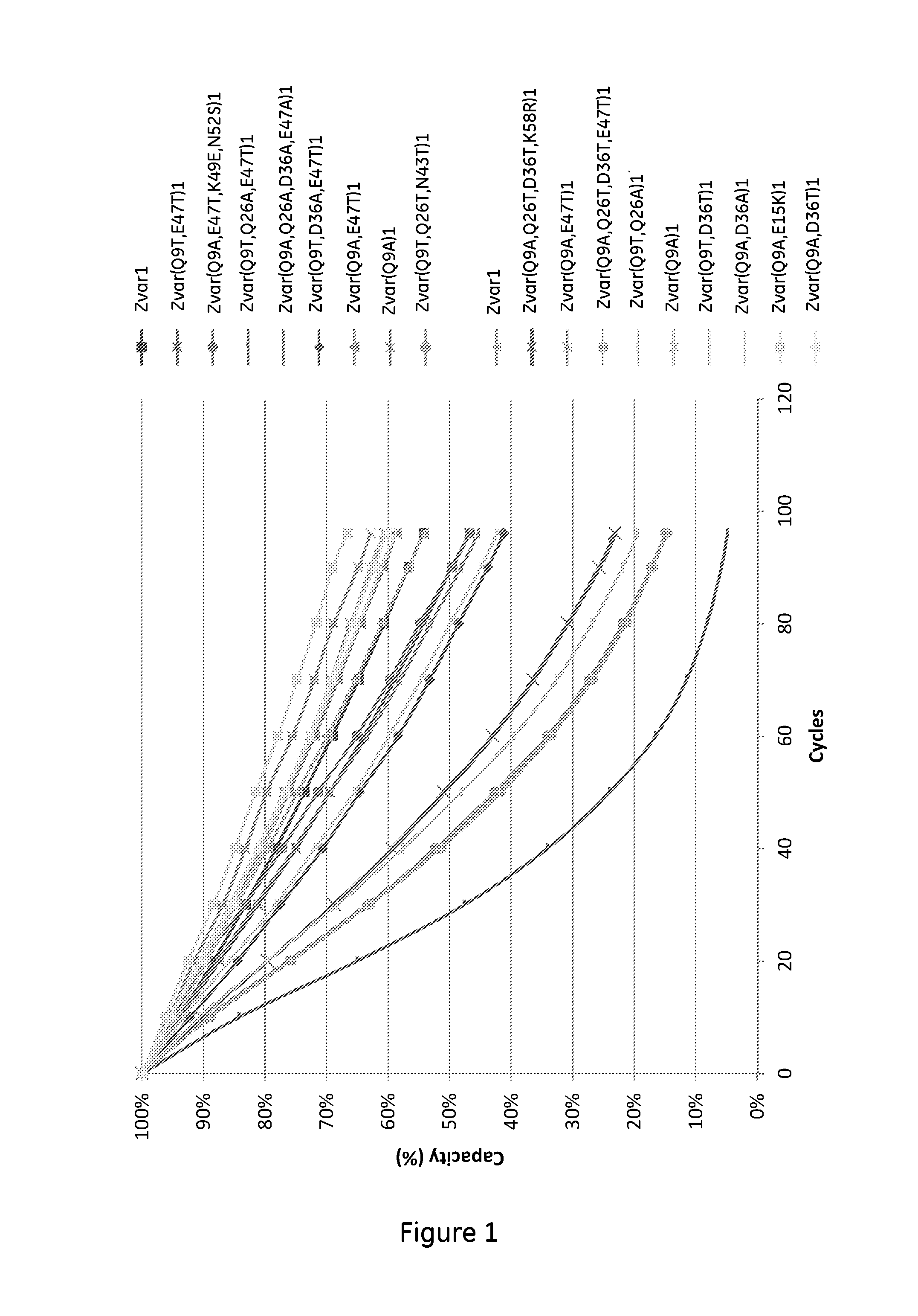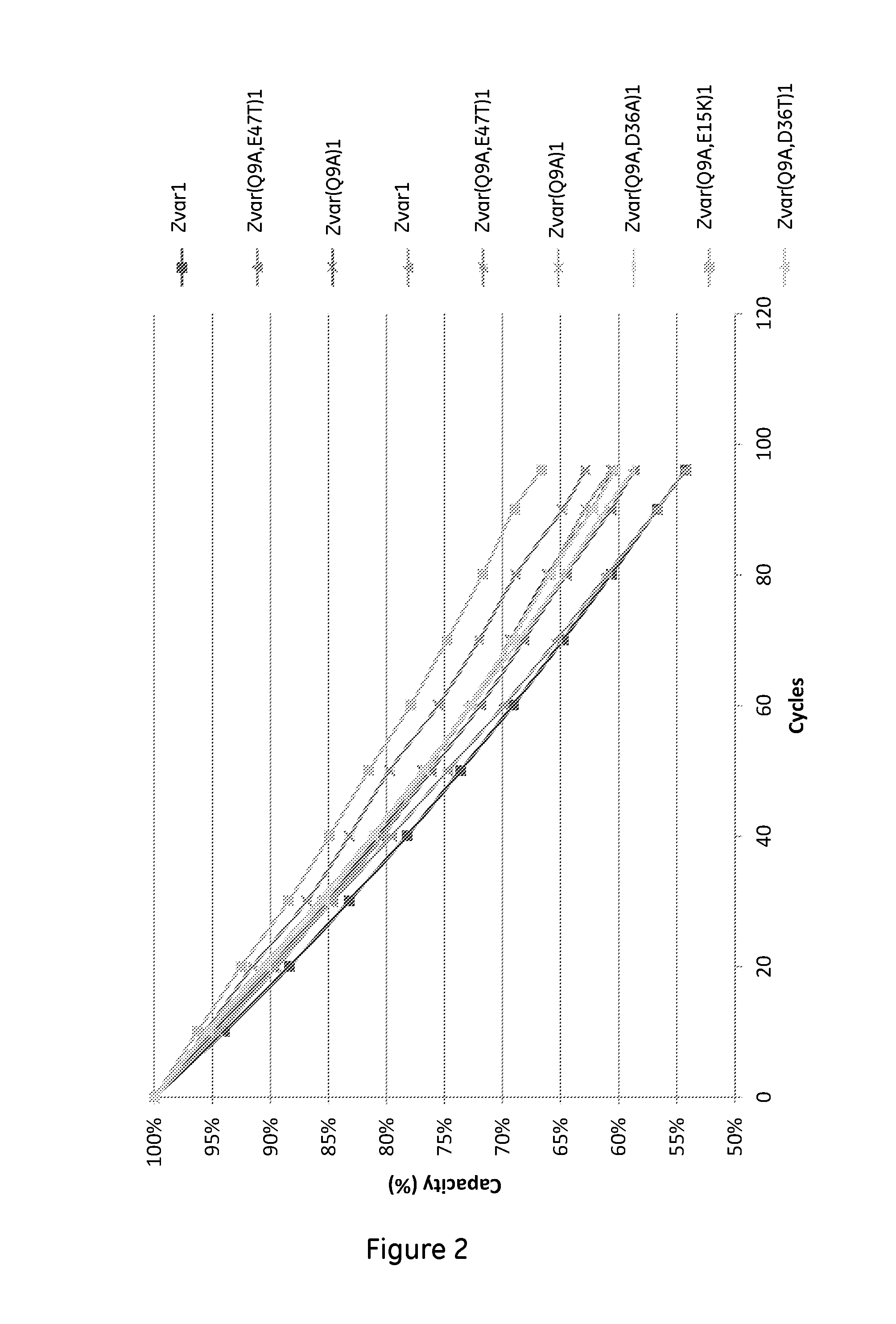Mutated immunoglobulin-binding polypeptides
a technology of immunoglobulin and polypeptide, which is applied in the field of affinity chromatography, can solve the problems of inability to achieve complete cleaning, and inability to achieve complete cleaning, and achieve the effect of improving alkaline stability
- Summary
- Abstract
- Description
- Claims
- Application Information
AI Technical Summary
Benefits of technology
Problems solved by technology
Method used
Image
Examples
example 1
[0066]The purified monomeric ligands listed in Table 1 were immobilized on Biacore CM5 sensor chips (GE Healthcare, Sweden), using the amine coupling kit of GE Healthcare (for carbodiimide coupling of amines on the carboxymethyl groups on the chip) in an amount sufficient to give a signal strength of about 1000RU in a Biacore instrument (GE Healthcare, Sweden). To follow the IgG binding capacity of the immobilized surface 1 mg / ml human polyclonal IgG (Gammanorm) was flowed over the chip and the signal strength was noted. The surface was then cleaned-in-place (CIP), i.e. flushed with 500 mM NaOH for 10 minutes at room temperature (22 + / −2° C.). This was repeated for 96 cycles and the immobilized ligand alkaline stability was followed as the relative loss of IgG binding capacity (signal strength) after each cycle. The results are shown in FIG. 1 and Table 1 and indicate that at least the ligands Zvar(Q9A)1, Zvar(Q9A,E15K)1, Zvar(Q9A,E47T)1, Zvar(Q9A,D36T)1, Zvar(Q9A,D36A)1 and Zvar(Q9...
example 2
[0067]The purified tetrameric ligands of Table 2 (all with an additional N-terminal cysteine) were immobilized on agarose beads using the methods described below and assessed for capacity and stability.
TABLE 2Initial RemainingRemaining IgG IgG capacityIgGSEQ Ligandcapacityafter 100capacity IDcontentQb 10cyclesafter 100 LigandNO.(mg / ml)(mg / ml)(mg / ml)cycles (%)Zvar4246.447.634.171.7Zvar(Q9A)4256.346.338.883.9Zvar(Q9A,E15K)4266.249.841.082.3Zvar(Q9A,E47T)4277.250.540.880.8
Activation
[0068]The base matrix used was rigid cross-linked agarose beads of 85 micrometers (volume-weighted) median diameter, prepared according to the methods of U.S. Pat. No. 6,602,990 and with a pore size corresponding to an inverse gel filtration chromatography Kav value of 0.70 for dextran of Mw 110 kDa, according to the methods described in Gel Filtration Principles and Methods, Pharmacia LKB Biotechnology 1991, pp 6-13.
[0069]25 mL (g) of drained base matrix, 10.0 mL distilled water and 2.02 g NaOH(s) was mixed...
PUM
| Property | Measurement | Unit |
|---|---|---|
| pH | aaaaa | aaaaa |
| pore size | aaaaa | aaaaa |
| temperature | aaaaa | aaaaa |
Abstract
Description
Claims
Application Information
 Login to View More
Login to View More - R&D
- Intellectual Property
- Life Sciences
- Materials
- Tech Scout
- Unparalleled Data Quality
- Higher Quality Content
- 60% Fewer Hallucinations
Browse by: Latest US Patents, China's latest patents, Technical Efficacy Thesaurus, Application Domain, Technology Topic, Popular Technical Reports.
© 2025 PatSnap. All rights reserved.Legal|Privacy policy|Modern Slavery Act Transparency Statement|Sitemap|About US| Contact US: help@patsnap.com



